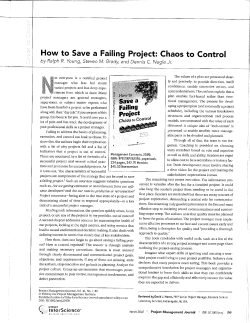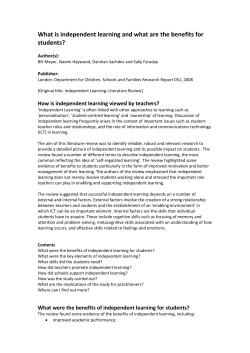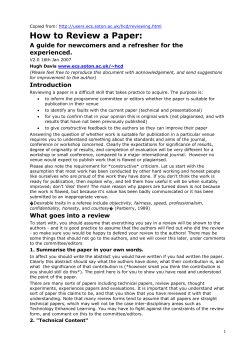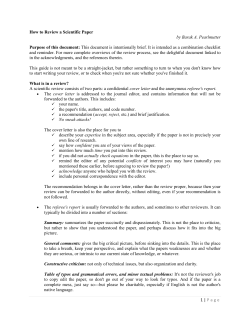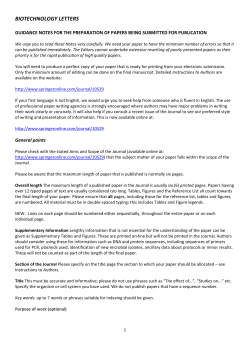
Sample Reading List — Massachusetts
Sample Reading List — Massachusetts Note: The only way to determine the rigor of academic expectations for literacy and informational text is to be explicit about the quality and complexity of the work students are asked to read and analyze. The following reading lists were developed by ADP partner states Indiana and Massachusetts and are included here so that readers can refer to these authors and titles when designing curricula to help students meet the ADP benchmarks. For the purposes of this report we have included only the lists of authors and works corresponding to the 9–12 grade span. The full Appendix A, including authors and works corresponding to the PreK–2, 3–4 and 5–8 grade spans, is available on the Massachusetts Department of Education Web site www.doe.mass.edu/frameworks/ela/0601.pdf. Massachusetts English Language Arts Curriculum Framework June 2001 Appendix A: Suggested Authors, Illustrators, and Works Reflecting Our Common Literary and Cultural Heritage All American students should acquire knowledge of a range of literary works reflecting a common literary heritage that goes back thousands of years to the ancient world. In addition, all students should become familiar with some of the outstanding works in the rich body of literature that is their particular heritage in the English-speaking world. This includes the first literature in the world created just for children—its authors viewing childhood as a special period in life. The suggestions in Appendix A constitute a core list of those authors, illustrators, or works that comprise the literary and intellectual capital drawn on by those who write in English, whether for novels, poems, nonfiction, newspapers, or public speeches, in this country or elsewhere. Knowledge of these authors, illustrators, and works in their original, adapted, or revised editions will contribute significantly to a student’s ability to understand literary allusions and participate effectively in our common civic culture. Many more suggested contemporary authors, illustrators, and works from around the world are included in Appendix B. This list includes the many excellent writers and illustrators of children’s books of recent years.* In planning a curriculum, it is important to balance depth with breadth. As teachers in schools and districts work with this curriculum framework to develop literature units, they will often combine works from the two lists into thematic units. Exemplary curriculum is always evolving—we urge districts to take initiative to create programs meeting the needs of their students. The lists of suggested authors and works in Appendices A and B are organized by the grade spans of PreK–2, 3–4, 5–8 and 9–12. Certain key works or authors are repeated in adjoining grade spans, giving teachers the option to match individual students with the books that suit their interests and developmental levels. The decision to present a Grades 9–12 list (as opposed to Grades 9–10 and 11–12) stems from the recognition that teachers should be free to choose selections that challenge, but do not overwhelm, their students. * Selections for PreK–8 on both Appendix A and Appendix B were reviewed by Roger Sutton, Editor-in-Chief, and Martha V. Parravano, Senior Editor of the Horn Book Magazine. We gratefully acknowledge their contributions. 7 ENGLISH BENCHMARKS A. Grades 9–12 In addition to the 5–8 Selections: Important Writers of the 18th Langston Hughes and 19th Centuries: Zora Neale Hurston Traditional and Classical literature: James Fenimore Cooper Sarah Orne Jewett A higher level rereading of Stephen Crane James Weldon Johnson Emily Dickinson Flannery O’Connor Frederick Douglass Gertrude Stein poetry: Homer’s Odyssey and Ralph Waldo Emerson John Steinbeck Iliad; Virgil’s Aeneid Benjamin Franklin James Thurber Nathaniel Hawthorne Jean Toomer (Aeschylus, Sophocles, Henry James Booker T. Washington Euripides) Thomas Jefferson Edith Wharton Herman Melville Richard Wright Greek mythology Substantial selections from epic Classical Greek drama The Bible as literature: Edgar Allan Poe Genesis, Ten Commandments, Henry David Thoreau In addition to the PreK–8 selected psalms and proverbs, Mark Twain Selections: Job, Sermon on the Mount, Phillis Wheatley selected parables Walt Whitman Playwrights: Lorraine Hansberry 1. American Literature Important Writers of the First Lillian Hellman Half of the 20th Century: Arthur Miller Historical Documents of Henry Adams Eugene O’Neill Literary and Philosophical James Baldwin Thornton Wilder Significance: Arna Bontemps Tennessee Williams Abraham Lincoln’s Gettysburg Willa Cather August Wilson address Kate Chopin The Declaration of Independence Countee Cullen Poets: Martin Luther King Jr.’s “Letter Ralph Ellison Elizabeth Bishop from Birmingham Jail” or his William Faulkner e e cummings “I Have a Dream” speech Jessie Fauset Robert Frost F. Scott Fitzgerald T. S. Eliot Charlotte Gilman Robinson Jeffers Ernest Hemingway Amy Lowell O. Henry Robert Lowell John F. Kennedy’s inaugural speech William Faulkner’s Nobel Prize lecture R E A DY O R N OT: C R E AT I N G A H I G H S C H O O L D I P LO M A T H AT CO U N T S 8 Sample Reading List — Massachusetts Edgar Lee Masters Romantic poets: William Blake, Edna St. Vincent Millay Lord Byron, Samuel Taylor Selections from an early novel: Marianne Moore Coleridge, John Keats, Percy Miguel de Cervantes’ Don Sylvia Plath Bysshe Shelley, William Ezra Pound Wordsworth John Crowe Ransom Victorian poetry: Matthew Edward Arlington Robinson Arnold, Elizabeth Barrett Theodore Roethke Browning, Robert Browning, Wallace Stevens Dante Gabriel Rossetti, Alfred Alan Tate Lord Tennyson Sara Teasdale William Carlos Williams Twentieth Century: W. H. Henry Fielding’s Joseph Andrews Oliver Goldsmith’s The Vicar of Wakefield Selections from John Bunyan’s allegory, Pilgrim’s Progress Satire, or mock epic, verse or prose: Lord Byron, Alexander Immigrant Experience: Works about the European, South Quixote Auden, A. E. Housman, Dylan Thomas, William Butler Yeats Drama: and East Asian, Caribbean, William Shakespeare Central American, and South Anton Chekhov, Henrik Ibsen, Pope, Jonathan Swift 19th century novels: American immigrant experience George Bernard Shaw, Oscar Jane Austen (Ole Rolvaag, Younghill Kang, Wilde Emily Brontë Abraham Cahan), the experi- Joseph Conrad ences of Native Americans, and Essays: Charles Dickens slave narratives (Harriet Jacobs). British essays: Fyodor Dostoyevsky 2. British and European Literature Joseph Addison George Eliot Sir Francis Bacon Thomas Hardy Samuel Johnson in “The Victor Hugo Rambler” Poetry: Charles Lamb Selections from Chaucer’s George Orwell Canterbury Tales Leonard Woolf Epic poetry: Dante and John Milton Sonnets: William Shakespeare, John Milton, Edmund Spenser Metaphysical poetry: John Donne, George Herbert, Andrew Marvell 9 Fiction: ENGLISH BENCHMARKS Mary Shelley Leo Tolstoy 20th century novels: Albert Camus Enlightenment essays: André Gide Voltaire James Joyce Diderot and other Franz Kafka Encyclopédistes Jean-Jacques Rousseau D. H. Lawrence Jean-Paul Sartre Virginia Woolf Note: For the purposes of this report we have included only the lists of authors and works corresponding to the 9–12 grade span. The full Appendix A, including authors and works corresponding to the PreK–2, 3–4 and 5–8 grade spans, is available on the Massachusetts Department of Education Web site www.doe.mass.edu/frameworks/ela/0601.pdf. Massachusetts English Language Arts Curriculum Framework June 2001 Appendix B: Suggested Authors and Illustrators of Contemporary American Literature and World Literature All students should be familiar with American authors and illustrators of the present and those who established their reputations after the end of World War II, as well as important writers from around the world, both historical and contemporary. During the last half of the 20th century, the publishing industry in the United States devoted increasing resources to children’s and young adult literature created by writers and illustrators from a variety of backgrounds. Many newer anthologies and textbooks offer excellent selections of contemporary and world literature. As they choose works for class reading or suggest books for independent reading, teachers should ensure that their students are both engaged and appropriately challenged by their selections. The lists following are organized by grade clusters PreK–2, 3–4, 5–8 and 9–12, but these divisions are far from rigid, particularly for the elementary and middle grades. Many contemporary authors write stories, poetry, and non-fiction for very young children, for those in the middle grades, and for adults as well. As children become independent readers, they often are eager and ready to read authors that may be listed at a higher level. As suggested earlier in the Reading and Literature Strand of this framework, teachers and librarians need to be good matchmakers, capable of getting the right books into a child’s hands at the right time. The lists below are provided as a starting point; they are necessarily incomplete, because excellent new writers appear every year. As all English teachers know, some authors have written many works, not all of which are of equally high quality. We expect teachers to use their literary judgment in selecting any particular work. It is hoped that teachers will find here many authors with whose works they are already familiar, and will be introduced to yet others. A comprehensive literature curriculum balances these authors and illustrators with those found in Appendix A. R E A DY O R N OT: C R E AT I N G A H I G H S C H O O L D I P LO M A T H AT CO U N T S 10 Sample Reading List — Massachusetts Grades 9–12 Contemporary American Literature Chaim Potok Robert Bly Reynolds Price Louise Bogan Annie Proulx Arna Bontemps Fiction: Ayn Rand Gwendolyn Brooks James Agee Richard Rodriguez Sterling Brown Maya Angelou Leo Rosten Hayden Carruth Saul Bellow Saki J. V. Cunningham Pearl Buck J. D. Salinger Rita Dove Raymond Carver William Saroyan Alan Dugan John Cheever May Sarton Richard Eberhart Sandra Cisneros Jane Smiley Martin Espada Arthur C. Clarke Betty Smith Allen Ginsberg E. L. Doctorow Wallace Stegner Louise Gluck Louise Erdrich Amy Tan John Haines Nicholas Gage Anne Tyler Donald Hall Ernest K. Gaines John Updike Robert Hayden Alex Haley Kurt Vonnegut, Jr. Anthony Hecht Joseph Heller Alice Walker Randall Jarrell William Hoffman Robert Penn Warren June Jordan John Irving Eudora Welty Galway Kinnell William Kennedy Thomas Wolfe Stanley Kunitz Ken Kesey Tobias Wolff Philip Levine Jamaica Kincaid Anzia Yezierska Audrey Lord Maxine Hong Kingston 11 Amy Lowell Jon Krakauer Poetry: Robert Lowell Harper Lee Claribel Alegria Louis MacNeice Bernard Malamud Julia Alvarez James Merrill Carson McCullers A. R. Ammons Mary Tall Mountain Toni Morrison Maya Angelou Sylvia Plath Joyce Carol Oates John Ashberry Anna Quindlen Tim O’Brien Jimmy Santiago Baca Ishmael Reed Edwin O’Connor Amiri Baraka (LeRoi Jones) Adrienne Rich Cynthia Ozick Elizabeth Bishop Theodore Roethke ENGLISH BENCHMARKS Anne Sexton Stephen Jay Gould Drama: Karl Shapiro John Gunther Edward Albee Gary Snyder John Hersey Robert Bolt William Stafford Edward Hoagland Jerome Lawrence and Robert E. Mark Strand Helen Keller May Swenson William Least Heat Moon Archibald MacLeish Margaret Walker Barry Lopez Terrence Rattigan Richard Wilbur J. Anthony Lukas Ntozake Shange Charles Wright Mary McCarthy Neil Simon Elinor Wylie Edward McClanahan Orson Welles Lee David McCullough Essay/Nonfiction John McPhee (Contemporary and William Manchester Historical): H. L. Mencken Edward Abbey N. Scott Momaday Susan B. Anthony Samuel Eliot Morison Russell Baker Lance Morrow Ambrose Bierce Bill Moyers Carol Bly John Muir Dee Brown Anna Quindlen Art Buchwald Chet Raymo William F. Buckley Richard Rodriguez Rachel Carson Eleanor Roosevelt Margaret Cheney Franklin D. Roosevelt Marilyn Chin Theodore Roosevelt Stanley Crouch Carl Sagan Joan Didion William Shirer Annie Dillard Shelby Steele W. E. B. Du Bois Lewis Thomas Gretel Ehrlich Cornell West Loren Eiseley Walter Muir Whitehill Henry Louis Gates, Jr. Malcolm X Doris Goodwin R E A DY O R N OT: C R E AT I N G A H I G H S C H O O L D I P LO M A T H AT CO U N T S 12 Sample Reading List — Massachusetts Grades 9–12 Historical and Contemporary World Literature Milan Kundera Philip Larkin Stanislaw Lem Czeslaw Milosz Primo Levi Gabriela Mistral Jacov Lind Pablo Neruda Fiction: Clarice Lispector Octavio Paz Chinua Achebe Naguib Mahfouz Jacques Prévert S. Y. Agnon Thomas Mann Alexander Pushkin Ilse Aichinger Alberto Moravia Salvatore Quasimodo Isabel Allende Mordecai Richler Juan Ramon Ramirez Jerzy Andrzejewski Alice Munro Arthur Rimbaud Margaret Atwood Vladimir Nabokov Pierre de Ronsard Isaac Babel V. S. Naipaul George Seferis James Berry Alan Paton Léopold Sédar Senghor Heinrich Böll Cesar Pavese Wole Soyinka Jorge Luis Borges Santha Rama Rau Marina Tsvetaeva Mikhail Bulgakov Rainer Maria Rilke Paul Verlaine Dino Buzzati Ignazio Silone Andrei Voznesensky A.S. Byatt Isaac Bashevis Singer Derek Walcott Italo Calvino Aleksandr Solzhenitsyn Yevgeny Yevtushenko Karl Capek Niccolo Tucci Carlo Cassola Mario Vargas-Llosa Essay/Nonfiction: Camillo Jose Cela Elie Wiesel Winston Churchill Julio Cortazar Emile Zola Mahatma Gandhi Isak Dinesen 13 Stephen Hawking E. M. Forster Poetry: Arthur Koestler Gabriel Garcia Marquez Bella Akhmadulina Margaret Laurence Nikolai Gogol Anna Akhmatova Michel de Montaigne William Golding Rafael Alberti Shiva Naipaul Robert Graves Josif Brodsky Octavio Paz Hermann Hesse Constantine Cavafis Jean-Jacques Rousseau Wolfgang Hildesheimer Odysseus Elytis Alexis de Tocqueville Aldous Huxley Federico García Lorca Voltaire Kazuo Ishiguro Seamus Heaney Rebecca West Yuri Kazakov Ted Hughes Marguerite Yourcenar ENGLISH BENCHMARKS Drama: Jean Anouilh Fernando Arrabal Samuel Beckett Bertolt Brecht Albert Camus Jean Cocteau Athol Fugard Jean Giraudoux Eugene Ionesco Molière John Mortimer Sean O’Casey John Osborne Harold Pinter Luigi Pirandello Jean-Paul Sartre John Millington Synge Religious Literature: Analects of Confucius Bhagavad-Gita The Koran Tao Te Ching Book of the Hopi Zen parables Buddhist scripture R E A DY O R N OT: C R E AT I N G A H I G H S C H O O L D I P LO M A T H AT CO U N T S 14
© Copyright 2025

